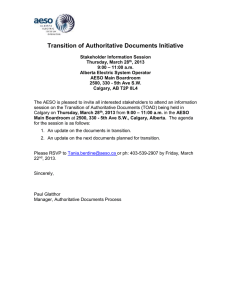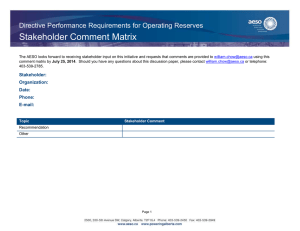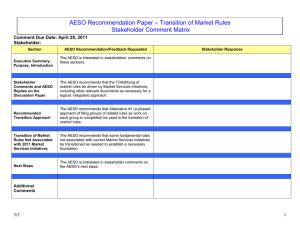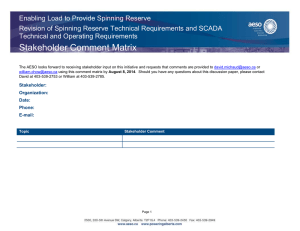– Short-Term Wind Integration AESO Recommendation Paper Stakeholder Comment Matrix
advertisement
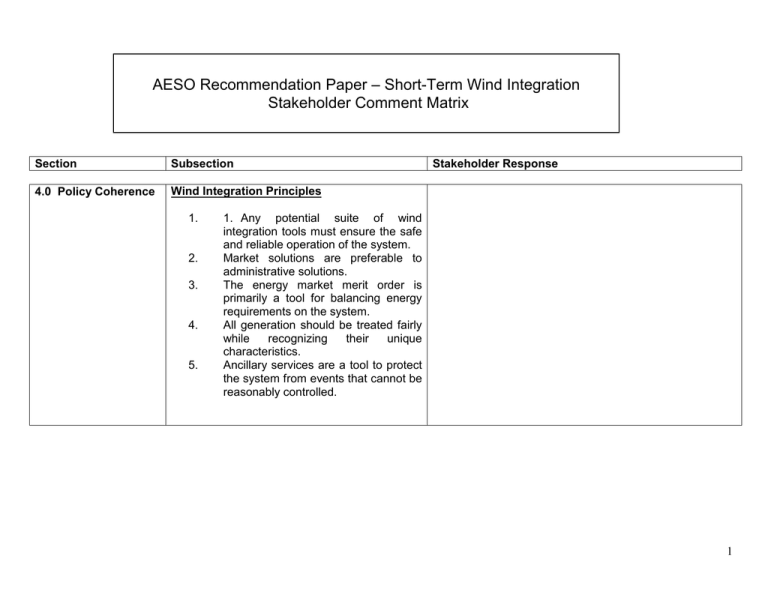
AESO Recommendation Paper – Short-Term Wind Integration Stakeholder Comment Matrix Section Subsection 4.0 Policy Coherence Wind Integration Principles 1. 2. 3. 4. 5. Stakeholder Response 1. Any potential suite of wind integration tools must ensure the safe and reliable operation of the system. Market solutions are preferable to administrative solutions. The energy market merit order is primarily a tool for balancing energy requirements on the system. All generation should be treated fairly while recognizing their unique characteristics. Ancillary services are a tool to protect the system from events that cannot be reasonably controlled. 1 5.0 Analysis 5.1 Source of ACE Events The AESO provided further clarification relative to the discussion paper that wind generation was a contributing factor in about 90% of ACE events. 5.2 WPM and Regulating Reserve Comparison The tradeoff between WPM and regulating reserve illustrates that WPM is about 5 to 10 times more efficient in resolving over generation situations. 6.0 Recommendations 6.1 Energy Market Merit Order The AESO recommends that the EMMO continue to be used as the primary tool to balance supply and demand in the market The AESO recommends that EMMO dispatches to accommodate wind power should not include dispatches solely intended to achieve a higher system ramp rate. The AESO recommends that a tool be developed that calculates the real-time ramping capability of the system under the assumption that dispatches are made for energy requirements. 6.2.1 Regulating Reserve The AESO recommends that regulating reserves should not be purchased or activated from standby to accommodate wind ramping up. 2 Analysis indicated that regulating reserve was not as efficient at mitigating wind ramp up events relative to WPM.. Wind ramping up is a controllable event, which suggests that it should not be managed with ancillary services paid for by load. 6.2.2 Contingency Reserves The AESO recommends that the loss of wind energy due to a decrease in wind speed should be treated as a generation contingency. As such, contingency reserves should be used to replace this energy. The AESO recommends that existing standby reserves (spinning and supplemental) be activated when there is a risk required ramp rate will exceed the available ramp due to a wind ramp down event. These standby activations will result in Alberta carrying more than the minimum level of contingency reserves in some hours. The AESO recommends that if the North West Power Pool allows contingency reserve to replace the unexpected loss of wind generation due to a reduction in wind speed, this practice should be followed in Alberta. 6.3 Wind Power Management The AESO recommends that wind generation ramping up be treated as a controllable event. WPM is the most efficient means currently available to manage wind ramp up events, and wind generators should bear the cost of managing the controllable elements of their 3 operations, just as all other generation types must. The AESO recommends that WPM be used to control the increase in wind energy only when the rate of wind energy increase exceeds the ability of the EMMO to accommodate it and the system is at risk of an over generation condition. WPM will not be used when wind generation has not contributed to an over generation condition, nor will it be used when wind generation is ramping more rapidly than the calculated limit but there is no risk of an over generation condition. 6.4 Wind Power Forecast The AESO recommends that the wind power forecast be integrated into the wind integration portfolio in order to increase the effectiveness of all tools. 7.0 Next Steps Since wind generators currently do not offer firm energy offers due to the intermittent nature of their ‘fuel’, a wind power forecast requirement has been identified as a reasonable alternative that provides information to both the system controller and the market on the expected operation and participation of wind aggregated generating facilities. 7.0 Next Steps The next steps in the wind integration program include: Receive stakeholder feedback on the phase one implementation plan. 4 8.0 Appendix Continue to integrate the wind power forecast into AESO systems. Continue development of the tool to calculate and disseminate the system wind power limit. Implement practices and any necessary new ISO rules or rules changes to use WPM and incremental ancillary services in a transparent manner. Release of Phase 2 discussion paper that examines incremental tools and market features for integrating wind on the system. Monitor and analyze the frequency of use and effectiveness of phase 1 tools. 8.2.1 System Wind Power Limit The system wind power limit for the next interval is calculated as the greater of: A Current wind production; plus 6.5 MW per minute increase Or B Current wind production; plus Expected increase (decrease) in load in the next interval; plus EMMO ramp rate down capability; plus Interchange Net Schedule Change (more exports or lower imports are positive, more imports or lower exports are negative) 5 8.2.2 Pro Rata Distribution of the SWPL Each wind aggregated generating facility subject to the WPM protocol will receive a pro rata share of the overall system wind power limit. The ‘potential MW’ data element required by the proposed ISO Rule 502.1 will be utilized in the pro rata calculation in lieu of actual production in situations where a facility has been limited and the data is available. 8.2.3 Impact of Transmission Constraints A wind aggregated generating facility that has had its production limited by a Remedial Action Scheme (RAS) or the Transmission Constraints Management (TCM) protocol is not exempt from WPM due to system ramp rate considerations. 8.2.4 Supply Surplus Considerations Supply surplus rules will operate independently of WPM. A facility limited by the WPM protocol is not exempt from the supply surplus protocol. Similarly, a facility that has had its output limited via the supply surplus protocol is not exempt from WPM. 6

